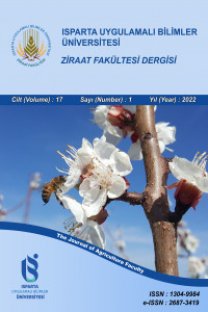Ayçiçeği Spektral Özelliklerinin Yetişme Dönemi Boyunca Değişiminin Değerlendirilmesi
Spektroradyometre, NDVI, Ayçiçeği, SAVI, SR
Evaluation Spectral Properties of Sunflower Throughout the Growing Season
Remote Sensing Spectroradiometer, Sunflower, NDVI, SAVI, SR,
___
- Allen R. G., Tasumi M ve Trezza R, 2007. Satellite-based energy balance for mapping evapotranspiration with internalized calibration (METRIC)—Model. Journal of irrigation and drainage engineering, 133(4): 380-394
- Alves I. ve Pereira L. S., 2000. Non-water-stressed baselines for irrigation scheduling with infrared thermometers: a new approach. Irrigation Science, 19(2): 101-106.Anonim, 2015. www.mgm.gov.tr.
- Anonim, 2016. www.fao.org.
- Aparicio N, Villegas D, Casadesus J, Araus J L ve Royo C, 2000. Spectral vegetation indices as nondestructive tools for determining durum wheat yield. Agronomy Journal, 92(1): 83-91
- Ayla C., 1974. Azot-Su İlişkileri ve Su Tüketiminin Tarla Parsellerinde Tespiti. Merkez TOPRAKSU Arastirma Enstutusu Mudurlugu Yayınları, 7
- Carlson T. N. ve Ripley D. A., 1997. On the relation between NDVI, fractional vegetation cover, and leaf area index. Remote sensing of environment, 62(3): 241-252
- Hatfield J. L., Sauer T. J. ve Prueger J. H., 2001. Managing soils to achieve greater water use efficiency. Agronomy Journal, 93(2): 271-280
- Idso S., Pinter P. ve Reginato R., 1990. Non-water-stressed baselines: the importance of site selection for air temperature and air vapour pressure deficit measurements. Agricultural and forest meteorology, 53(1-2): 73-80
- Inoue Y., 1997. Remote sensing of crop and vegetative environment. Journal of Japan remote sensing society, 17(4): 57-67
- Jackson R., Pinter Jr P., Reginato R. ve Idso S., 1980. Hand-held radiometry: A set of notes developed for use at the Workshop of Hand-held radiometry.
- Jackson R., Reginato R. ve Idso S., 1977. Wheat canopy temperature: a practical tool for evaluating water requirements. Water resources research, 13(3): 651-656Jiang R., Xie J., He H., Kuo C-C., Zhu J. ve Yang M., 2016. Spatiotemporal variability and predictability of Normalized Difference Vegetation Index (NDVI) in Alberta, Canada. International journal of biometeorology, 60(9): 1389-1403
- Kimura R., Okada S., Miura H. ve Kamichika M., 2004. Relationships among the leaf area index, moisture availability, and spectral reflectance in an upland rice field. Agricultural Water Management, 69(2): 83-100
- Köksal E., 2007. Sulama Suyu Yönetiminde Uzaktan Algılama Tekniklerinin Kullanımı. J. of Fac. of Agric., OMU, 22(3): 306-315
- Köksal E. S., Güngör Y. ve Yildirim Y E., 2011. Spectral reflectance characteristics of sugar beet under different levels of irrigation water and relationships between growth parameters and spectral indexes. Irrigation and Drainage, 60(2): 187-195
- Kross A., McNairn H., Lapen D., Sunohara M. ve Champagne C., 2015. Assessment of RapidEye vegetation indices for estimation of leaf area index and biomass in corn and soybean crops. International Journal of Applied Earth Observation and Geoinformation, 34: 235-248
- Kustas W. P. ve Daughtry C. S., 1990. Estimation of the soil heat flux/net radiation ratio from spectral data. Agricultural and forest meteorology, 49(3): 205-223Moran M., Clarke T., Inoue Y. ve Vidal A., 1994. Estimating crop water deficit using the relation between surface-air temperature and spectral vegetation index. Remote sensing of environment, 49(3): 246-263
- Peñuelas J., Gamon J., Fredeen A., Merino J. ve Field C., 1994. Reflectance indices associated with physiological changes in nitrogen-and water-limited sunflower leaves. Remote sensing of environment, 48(2): 135-146
- Peters A. J., Walter-Shea E. A., Ji L., Vina A., Hayes M. ve Svoboda M. D., 2002. Drought monitoring with NDVI-based standardized vegetation index. Photogrammetric engineering and remote sensing, 68(1): 71-75
- Sharma P., 2007. Precision Farming. New Delhi, Gene Tech Books.
- Siyal A. A., Dempewolf J. ve Becker-Reshef I., 2015. Rice yield estimation using Landsat ETM+ Data. Journal of Applied Remote Sensing, 9(1): 095986-095986
- Vina A., Gitelson A. A., Rundquist D. C., Keydan G., Leavitt B. ve Schepers J., 2004. Monitoring maize (L.) phenology with remote sensing. Agronomy Journal, 96(4): 1139-1147
- ISSN: 1304-9984
- Yayın Aralığı: Yılda 2 Sayı
- Başlangıç: 2006
- Yayıncı: Isparta Uygulamalı Bilimler Üniversitesi
Ahmet ALMACA, Kübra Sedef İRAZ
Zafer Ali SERBEŞ, Umut OKKAN, Şerafettin AŞIK
Nada JOUMA, Filiz DADASER CELIK
Farklı Bor Konsantrasyonlarının Ekmeklik Buğday Çeşitlerinin Çimlenmesi Üzerine Etkileri
Ezgi KURTULMUŞ, Hayrettin KUŞÇU, Bilge ARSLAN, İpek KARAKUŞ, Emir KUMRALTEKİN, İdil Eylül UÇAN, Mehmet Can AŞIK
Sedat BOYACI, Gökhan FİLİK, Ayşe Gül FİLİK
Arazi Toplulaştırma Projelerinde Yol Uzunluklarının Analizi: Şanlıurfa Türkeli Köyü Örneği
Hamza KUZU, Fırat ARSLAN, Hasan DEĞİRMENCİ
Alanya Yöresi Muz Bahçelerinin Beslenme Durumlarının Belirlenmesi
İbrahim ERDAL, Merve DURNAOĞULLARI
Sakine ÇETİN, Eyüp Selim KÖKSAL, Emre TUNCA
Siirt Yöresi Fıstık Üreticilerinin Sulama Egilimlerinin Belirlenmesi
Şeftali Çekirdeği ve Linyit Kömür Tozundan Yapilan Peletlerin Fiziko Mekanik Özellikleri
Serdar ÜÇOK, Orhan A. ATAY, Kamil EKİNCİ, Hüseyin KAÇAR, Barbaros S. KUMBUL, Ali AYBEK
